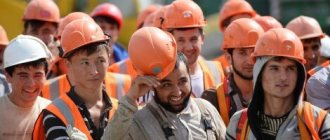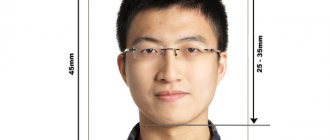Reasons for migration
The reasons for migration can be of different nature, and, depending on their origin, migrations are distinguished:
- economic,
- political,
- national,
- legal,
- racial,
- cultural,
- religious,
- psychological,
- cultural,
- environmental.
Population movement is facilitated by such factors as: economic, social, natural and climatic.
Economic migration is caused by different levels of economic development in different countries, which is reflected in wages and the general level of social security; the discrepancy between the quantity of the workforce, the education of workers and the material and technical base of the state; insufficient labor market volume.
The reasons for relocation can be individual, group or mass in nature.
The reasons for migration can be typical or special, objective or subjective.
Finished works on a similar topic
- Coursework Causes of population migration 450 rub.
- Abstract Causes of population migration 220 rub.
- Test work Reasons for population migration 230 rub.
Receive completed work or advice from a specialist on your educational project Find out the cost
Note 1
When analyzing the causes of migration, special attention must be paid to the relationship between social and economic factors in the life of the population, which is reflected in the different levels of development of countries.
A special place among all the reasons for migration is occupied by the ecological situation, the state of the environment, which has a direct impact on the health of the population.
A close correlation between environmental pollution, morbidity and population migration has been scientifically proven.
Impact of migration on population structure
Definition 1
Population migration is a complex social process that affects almost all aspects of the economic, social and cultural life of peoples. The structure of the country's population is formed under the influence of natural movement and under the influence of migration processes.
As a result of population migration, the following changes in demographic processes are observed:
- the gender and age structure of the population is changing;
- the ethnic composition is disrupted;
- social composition changes;
- in areas with population outflow exceeding replacement, the birth rate decreases and the proportion of the elderly population increases;
- in areas with an influx of migrants, the proportion of young people is growing, and the rate of reproduction is increasing;
- the quantity and quality of labor resources changes.
Finished works on a similar topic
- Coursework The impact of migration on the population 480 rub.
- Abstract The impact of migration on the population 250 rub.
- Test work The influence of migration on the population 230 rubles.
Receive completed work or specialist advice on your educational project Find out the cost
Demographic dynamics are predetermined by the following components: fertility, mortality, migration. Each component influences the formation of the age structure.
Note 1
One of the goals of the concept of replacement migration, developed by the UN in the 90s. XX century – counteracting demographic aging. Replacement migration occurs where natural population reproduction is insufficient to replace generations. Migration compensates for the “natural” population decline and mitigates the consequences of its aging, compensating for the reduction in the working-age share of the population. Migration policies lead to faster results than measures in the field of fertility and mortality.
Attracting migrants increases the working-age population. However, some migrants are of pre-retirement age or elderly, which subsequently leads to an aging population.
The composition of migrants affects the educational and cultural level of the population. Thus, the relocation of residents from the city to rural areas or areas remote from civilization contributes to the formation of a higher level of professional qualifications and culture among the local population; on the contrary, the influx of the rural population into cities has the opposite effect.
Need advice from a teacher in this subject area? Ask a question to the teacher and get an answer in 15 minutes! Ask a Question
The influx of migrants of reproductive age is contributing to a change in demographic trends. As a rule, the birth rate among migrants is higher than that of the local population, which leads to an increase in ethnocultural diversity. With the outflow of part of the indigenous population, this can lead to serious problems in the state.
Reasons for migration
The most typical reasons for migration are:
- desire to improve conditions and quality of life;
- more favorable conditions of payment and work, search for opportunities for self-realization in professional activities;
- restructuring of production facilities, changing their regional location;
- deterioration of the environmental situation in the place of permanent residence;
- need for climate change for health reasons, accompanying relatives;
- the desire to change life, the need for cultural development;
- deterioration of working conditions, development of conflicts at work;
- entering into a legal marriage, uniting with loved ones;
- conflicts in the family;
- military operations, the emergence of ethnic and social conflicts;
- random circumstances, etc.
Need advice on your academic work? Ask a question to the teacher and get an answer in 15 minutes! Ask a Question
Note 2
International migration most often occurs for external and economic reasons. External economic reasons include: political factors, unification and collapse of states, wars, religious reasons, natural disasters and environmental problems, personal reasons
Economic migrations facilitate the movement of large populations towards countries with highly developed economies. Migration related to economic reasons is often called labor migration. Labor migration can last from several months to several years. The most attractive countries for labor migration: Canada, USA, Australia, Western Europe, South Africa, oil-producing countries of the Middle East, Latin America and countries of the Asia-Pacific region.
International labor migration is characterized by a constantly increasing proportion of highly qualified specialists in its composition.
As a rule, population movements are influenced by a combination of reasons, between which it is difficult to draw a line. Economic and social reasons are closely interconnected. Social reasons for migration include: marriage and reunification with loved ones, living in another country while receiving education.
The main political reason for migration is the change of government in the country. If the existing political regime in a country contradicts a person’s civic position, then migration shows this person’s open rejection of the political situation. Sometimes in such situations, migration is the only way to escape persecution by the authorities.
Military reasons for migration are the most terrible and severe manifestations, when the population is forced to flee from their habitable places in order to save their lives and the lives of their loved ones. Migration due to military operations is accompanied by a huge number of refugees and is spontaneous.
The main reason for cultural migration is the return to their historical homeland, where a person can restore lost ethnic ties by visiting sites of the historical heritage of his people and becoming familiar with their traditions.
Note 3
When considering the causes of migration, it is often possible to distinguish the migration of different social groups. The most powerful influence on the development of society is the impact of labor migration. Such migrations cover large sections of the working-age population.
Types of migration
It is customary to distinguish the following types of external migration:
- irrevocable migration associated with a change of residence and acquisition of citizenship of the host country
- long-term migration, implying movement for a long period of more than 1 year
- short-term migration – visiting another country or region for a period of less than 1 year
Need some teacher advice on a similar topic? Ask a question to the teacher and get an answer in 15 minutes! Ask a Question
Short-term migration, in turn, is divided into the following types of migration:
- seasonal migration, which consists of moving the population for a certain season of the year
- pendulum migration, which is determined by the movement of the population systematically once a day or once a week to the place of work or education
- episodic migration, characterized by staying in a country or region outside of one’s place of residence for a certain period for the purposes of tourism, recreation, treatment, etc.
Causes and types of international migration
Migration flows are divided into external (between countries and continents) and internal (within the country). The main reasons for external migration of the population are as follows:
- instability of the political situation in the state;
- unemployment;
- low standard of living;
- ecological problems;
- lack of opportunity to realize your professional or creative potential;
- military conflicts, etc.
In global migration processes, the main external factors of migration still have an economic background. Some people are fleeing unemployment, while others - scientists, artists, actors - are looking for a place where their work would be appreciated.
Depending on the reasons causing a person’s need to change their place of residence, different types of external migration can be distinguished:
- emigration - departure of citizens from their home country to another state for permanent residence or a long-term stay;
- immigration - the entry of citizens into another country with the aim of settling there permanently or for a long time;
- labor migration is a legal move outside one’s country for the purpose of engaging in labor activity (according to the UN classification, migrant workers are persons who arrive in another country to work for a period exceeding one year).
As long as the socio-political and socio-economic situation in our country remains difficult, Russians will look for work abroad. Experts believe that the number of people wishing to go to work could reach 5 million people annually.
Other types
When talking about the movement of people outside their home country, we can mention a functional feature. The purpose of such a move may be tourism, business travel, treatment, or cultural study. In addition to them, there are other groups of people traveling to another country:
- students;
- teachers;
- refugees;
- illegal immigrants.
But the main feature of external migration of the population is territorial. Its consequence is a change in the geography of human settlement.
Reasons for economic migration
Economic migration plays a major role in modern migration processes.
Labor migration is becoming a typical manifestation of the socio-economic life of modern society.
International labor migration processes are created by national differences in wages. In the modern world, labor is moving from labor-rich countries to capital-rich countries. More than half of labor migrants come from developing countries, most of whom settled in industrialized countries. The influx of new migrants into these countries is associated with qualitative imbalances in the labor markets.
Do you need to select material for your study work? Ask a question to the teacher and get an answer in 15 minutes! Ask a Question
The strongest center of attraction for migrants has formed in Western Europe, the USA, and Canada.
The main suppliers of labor are the countries of Asia (Pakistan, India, Malaysia, Philippines), Africa (Algeria, Morocco, Tunisia, Mali, Ghana, Guinea, Chad, Mozambique), the Middle East (Jordan, Lebanon, Turkey), North America (Mexico ), Europe (Portugal, Poland, Ireland, Italy).
Reasons for economically driven migration:
- economic crisis and falling living standards in the poorest countries;
- manifestation of disproportion between the demographic and economic development of the country;
- a reflection of the internal contradictions of society, aggravated by recurring crisis situations;
- high unemployment;
- search for higher wages and better conditions;
- functioning of international corporations;
- moving to relatives and friends, which makes it easier to enter the labor market.








